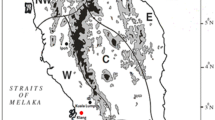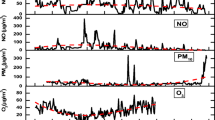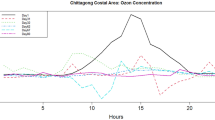Abstract
A multivariate time series approach vector autoregression (VAR) along with impulse response function and variance decomposition technique has been employed to look into the interrelationship among O3, NO, NO2, and volatile organic compounds (VOCs, namely, benzene, ethylbenzene, toluene, and xylene in the present study) using 3 months long continuous time series data of 1 h average concentration of these pollutants at one of the traffic sites in Delhi, India. It is found that the VAR of order 2 (i.e., past two lagged values of 1 h interval) is sufficient to represent the observed time series at the station studied. The impulse response function and variance decomposition analysis indicate that O3 concentration shows an immediate rise and persists for a longer duration (typically 8–10 h) once the impulse of NO2, benzene, ethylbenzene, or xylene is given in the ambient environment. However, in case of toluene, the reverse effect has been observed. Since O3 forms in the troposphere due to photolysis of NO2, it is not surprising that its impulse triggers O3 formation in the ambient environment. However, in case of VOCs, this has been attributed to their tendency to show higher inclination toward intermediary reactions leading to the formation of O3 rather than their (VOCs) reaction with O3. Among VOCs, only toluene has been observed to show higher inclination toward its reaction with O3. Apart from this, variance decomposition technique also reveals that the relation of NO with NO2 is more important than the relation of NO with O3 creating a conducive atmosphere for O3 formation in the present scenario. Thus, the multivariate time series approach provides significant insight about the role played by the dominant individual VOCs and NO x in influencing the O3 concentration in ambient urban atmosphere whereas a photochemical modeling approach gives an overall view of NO x and VOCs behavior with respect to O3 by using the O3 isopleth technique.





Similar content being viewed by others
References
Akaike, H. (1974). A new look at the statistical model identification. IEEE Transactions on Automatic Control, 19(6), 716–723. doi:10.1109/TAC.1974.1100705.
Atkinson, R. (2000). Atmospheric chemistry of VOCs and NO x . Atmospheric Environment, 24, 2063–2101. doi:10.1016/S1352-2310(99)00460-4.
Atkinson, R., & Lloyd, A. C. (1984). Evaluation of kinetic and mechanistic data for modeling photochemical smog. Journal of Physical and Chemical Reference Data, 13, 315.
Bierns, H. J. (2004). Information criteria and model selection. Lecture notes. Retrieved from http://grizzly.la.psu.edu/~hbierens/INFORMATIONCRIT.PDF.
Carter, W. P. L., & Lurmann, F. (1990). Evaluation of the RADM Gas-Phase Chemical Mechanism., Final Report, EPA-600/3-90-001.
Davidson, J. E. H., Hendry, D. F., Sbra, F., & Yeo, S. (1978). Econometric modelling of aggregate time series relationship between consumers’ expenditure and income in the United Kingdom. The Economic Journal, 88, 661–692. doi:10.2307/2231972.
Dutot, A. L., Rynkiewicz, J., Steiner, F. E., & Rude, J. (2007). A 24-h forecast of ozone peaks and exceedance levels using neural classifiers and weather predictions. Environmental Modelling & Software, 22(9), 1261–1269. doi:10.1016/j.envsoft.2006.08.002.
Finlayson-Pitts, B. J., & Pitts, J. N. (1986). Atmospheric chemistry: fundamentals and experimental techniques. John Wiley & Sons.
Finlayson-Pitts, B. J., & Pitts, J. N. Jr. (1993). Atmospheric chemistry of tropospheric ozone formation: scientific and regulatory implications. Journal of Air & Waste Management Association, 43, 1091–1100.
Franses, P. H. (1998). Time series models for business and economic forecasting. Cambridge: Cambridge University Press.
Gery, M. W., Whitten, G. Z., & Killus, J. P. (1988). Development and testing of the CBM-IV for urban and regional modelling., EPA-600/3-88-012, January.
Gery, M. W., Whitten, G. Z., Killus, J. P., & Dodge, M. C. (1989). A photochemical kinetics mechanism for urban and regional scale photochemical modeling. Journal of Geophysical Research, 94, 12925–12956. doi:10.1029/JD094iD10p12925.
Gujrati, D. N. (1995). Basic econometrics. New York: McGraw Hill.
Hamilton, J. D. (1994). Time series analysis. Princeton: Princeton University Press.
Hannan, E. J., & Quinn, B. G. (1979). The determination of the order of an autoregression. Journal of the Royal Statistical Society, B, 41, 190–195.
Hsu, K. (1992). Time series analysis of the interdependence among air pollutants. Atmospheric Environment, 26(4), 491–503.
Kumar, K., Yadav, A. K., Singh, M. P., Hassan, H., & Jain, V. K. (2004). Forecasting daily maximum surface ozone concentrations in Brunei Darussalam—an ARIMA modelling approach. Journal of the Air & Waste Management Association, 84, 809–814.
Lutkepohl, H. (2005). New introduction to multiple time series analysis. Berlin: Springer.
Masters, G. M. (1998). Introduction to environmental engineering and science. Singapore: Pearson Education.
Prior, E. J., Schiess, J. R., & McDougal, D. S. (1981). Approach to forecasting daily maximum ozone levels in St. Louis. Environmental Science & Technology, 15, 430–436.
Robeson, S. M., & Steyn, D. G. (1989). A conditional probability density function for forecasting ozone air quality data. Atmospheric Environment, 23, 689–692. doi:10.1016/0004-6981(89)90016-4.
Robeson, S. M., & Steyn, D. G. (1990). Evaluation and comparison of statistical forecast models for daily maximum ozone concentrations. Atmospheric Environment, 24B, 303–312.
Schlink, U., Herbarth, O., Richter, M., Dorling, S., Nunnari, G., Cawley, G., et al. (2006). Statistical models to assess the health effects and to forecast ground-level ozone. Environmental Modelling & Software, 21(4), 547–558. doi:10.1016/j.envsoft.2004.12.002.
Schwarz, G. (1978). Estimating the dimension of a model. Annals of Statistics, 6, 461–464. doi:10.1214/aos/1176344136.
Simpson, R. W., & Layton, A. P. (1983). Forecasting peak ozone levels. Atmospheric Environment, 17, 1649–1654. doi:10.1016/0004-6981(83)90173-7.
Sims, C. A. (1972). Money, income and causality. The American Economic Review, 62, 540–563.
Sims, C. A. (1980). Macroeconomics and reality. Econometrica, 48, 1–48.
Stockwell, W. R., Middleton, P., Chang, J. S., & Tang, X. (1990). The second generation regional acid deposition model chemical mechanism for regional air quality modeling. Journal of Geophysical Research, 95, 16343–16376. doi:10.1029/JD095iD10p16343.
Acknowledgement
One of the authors, Dr. Ujjwal Kumar, would like to thank University Grant Commission (UGC), New Delhi, India for providing financial support during the course of this study. The necessary financial support provided by the Council of Scientific and Industrial Research (CSIR), New Delhi, India to Mr. Amit Prakash is also duly acknowledged.
Author information
Authors and Affiliations
Corresponding author
Rights and permissions
About this article
Cite this article
Kumar, U., Prakash, A. & Jain, V.K. A Multivariate Time Series Approach to Study the Interdependence among O3, NO x , and VOCs in Ambient Urban Atmosphere. Environ Model Assess 14, 631–643 (2009). https://doi.org/10.1007/s10666-008-9167-1
Received:
Accepted:
Published:
Issue Date:
DOI: https://doi.org/10.1007/s10666-008-9167-1




